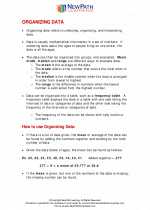Organizing Data -> elimination
Elimination in Linear Equations
What is Elimination?
Elimination is a method used to solve a system of linear equations by adding or subtracting the equations in order to eliminate one of the variables. This allows us to solve for the value of the remaining variable.
Steps for Using the Elimination Method
- Make sure the equations are in standard form: Ax + By = C
- Choose the variable to eliminate. This is usually the variable with the same coefficient or opposite coefficient in both equations.
- Multiply one or both equations by a constant if necessary to make the coefficients of one of the variables the same or opposites.
- Add or subtract the equations to eliminate the chosen variable.
- Solve for the remaining variable.
- Substitute the value found in step 5 back into one of the original equations and solve for the other variable.
Example
Solve the system of equations using the elimination method:
2x + 3y = 11
4x - 3y = 5
Solution:
Multiply the second equation by 3 to make the coefficients of y the same but opposite:
12x - 9y = 15
Add the original first equation and the modified second equation:
2x + 3y + 12x - 9y = 11 + 15
14x = 26
Solve for x: x = 26 / 14 = 13 / 7
Substitute x = 13 / 7 into the first equation:
2(13 / 7) + 3y = 11
26 / 7 + 3y = 77 / 7
3y = 51 / 7
Solve for y: y = (51 / 7) / 3 = 51 / 21
Study Guide
When using the elimination method, it's important to follow these key steps:
- Identify the variable to eliminate
- Make the coefficients of the chosen variable the same or opposites by multiplying the equations by constants
- Add or subtract the equations to eliminate the chosen variable
- Solve for the remaining variable
- Substitute the value back into one of the original equations to solve for the other variable
Practice with various examples to become fluent in using the elimination method to solve systems of linear equations.
.◂Math Worksheets and Study Guides Seventh Grade. Organizing Data

 Worksheet/Answer key
Worksheet/Answer key
 Worksheet/Answer key
Worksheet/Answer key
 Worksheet/Answer key
Worksheet/Answer key
